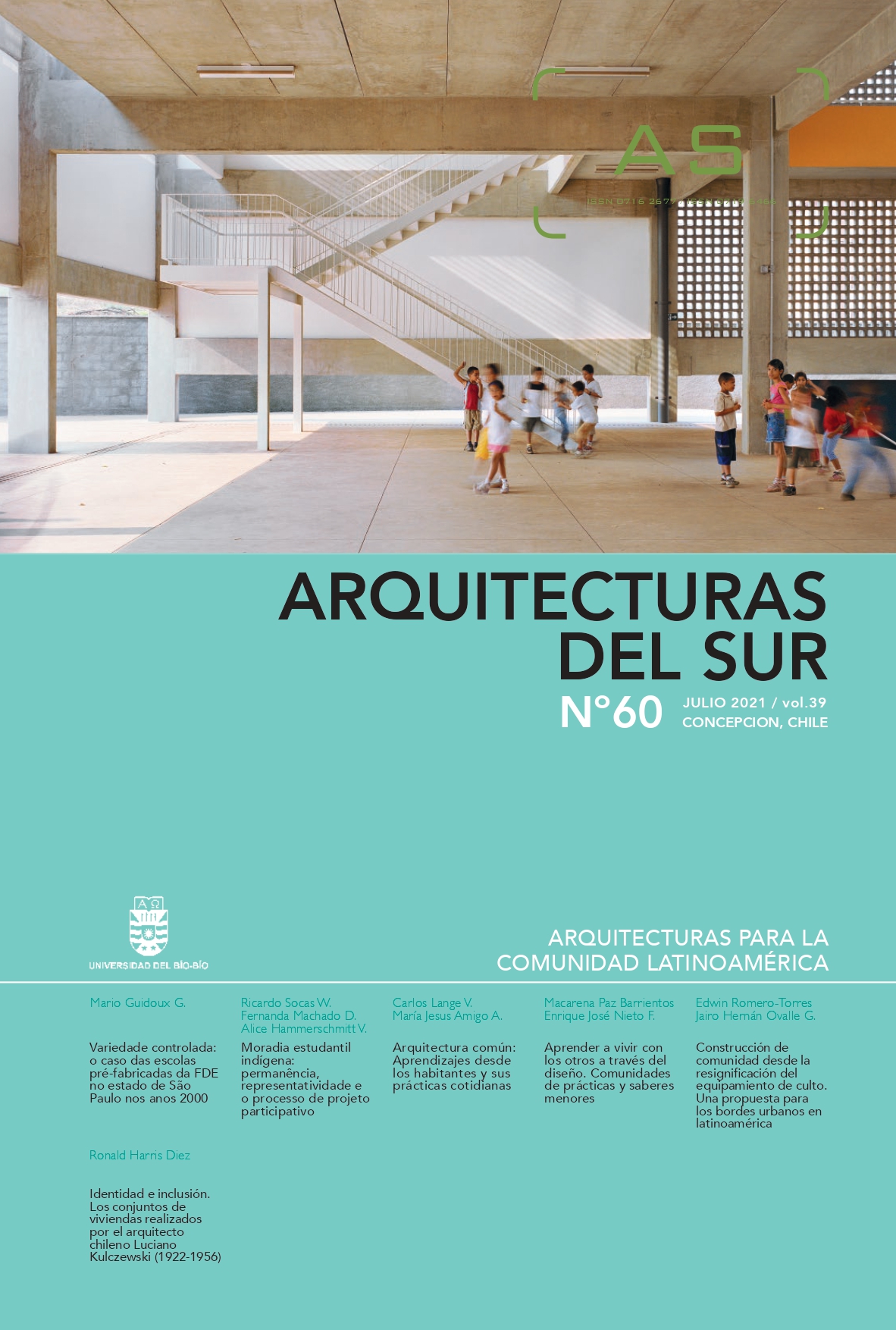Identity and inclusion. The housing complexes made by the Chilean architect Luciano Kulczewski (1922-1956)
DOI:
https://doi.org/10.22320/07196466.2021.39.060.06Keywords:
garden cities, housing complexes, architectural identity, social inclusion, cooperative housingAbstract
Luciano Kulczewski was a professional who played a key and distinctive role in the first half of the 20th century, a period considered as crucial for the development of Chilean architecture, since it is the moment that brought the advent of modernity to the country. One of the most eloquent illustrations in this regard is the corpus, that collects more than a dozen housing complexes aimed for the middle and the working classes. Today, we recognize in these solutions not just the fact that they are in sync with the web of social, political, cultural, and economic processes that characterized the beginnings of the past century in Chile, but that they also have, among their most notable merits, having been conceived in terms of what we would understand today by “inclusion”. This article seeks to investigate these parameters, which range from urban proposals - that approached the city in "inclusive" terms - inasmuch as they did not push for these housing proposals to be in the metropolitan peripheries - to more particular issues, such as the stylistic management of homes as a tool to serve identity causes, in order to achieve the integration of the user with their environment.
Downloads
References
AFACAN, Y. Y AFACAN S. (2011). Rethinking social inclusivity: design strategies for cities. Urban Design and Planning, 164(2), 93–105. DOI: 10.1680/udap.2011.164.2.93
AGUIRRE, M. (2011). La arquitectura moderna en Chile (1907-1942). Revistas de Arquitectura y estrategia gremial. Santiago de Chile: Editorial Universitaria.
ANÓNIMO (1939). Primer Congreso Panamericano de la Vivienda Popular celebrado en Buenos Aires. Urbanismo y arquitectura (5), 198/92-204/98.
BURMEISTER, E. (1969). Aportes individuales al desarrollo de la arquitectura chilena: la obra del arquitecto Luciano Kulczewski (Seminario de investigación de pregrado). Universidad de Chile, Santiago de Chile.
DUK, C. Y MURILLO, J. (2016). La Inclusión como Dilema. Revista latinoamericana de educación inclusiva, 10(1), 11-14. DOI: https://dx.doi.org/10.4067/S0718-73782016000100001
ELIADE, M. (1988). Lo sagrado y lo profano. Barcelona: Editorial Labor.
FUENTES, P. (2009). Antecedentes de la Arquitectura Moderna en Chile 1894 – 1929. Concepción: Ediciones Universidad del Bío-Bío.
GALAZ-MANDAKOVIC, D. (2011). Edificios Colectivos de la Caja del Seguro Obrero Obligatorio de Tocopilla 1939-41. Movimiento Moderno, solución social. Tocopilla, Chile: Retruecanosinversos.
GONZÁLEZ, K. (2019). Lineamientos de intervención para Zona Típica Población Madrid (Seminario de postgrado, Postítulo en conservación y restauración arquitectónica). Santiago de Chile: Universidad de Chile.
HARRIS, R. (2020). La moderna gestión de Luciano Kulczewski. Los casos de los Edificios Colectivos para Obreros de Arica e Iquique. AUS [Arquitectura/Urbanismo/Sustentabilidad] (27), 12-17. DOI:10.4206/aus.2020.n27-03
HARRIS, R. (2018). Contaminaciones estilísticas en la obra de Luciano Kulczewski. Yuxtaposición de imaginarios como estrategia de apropiación. Revista 180 (41), 44-53. DOI: http://dx.doi.org/10.32995/rev180.Num-41.(2018).art-397
HARRIS, R. (2016). Caracterización mediática del corpus productivo de Luciano Kulczewski. En P. Corro y C. Robles (Eds.), Estética, medios masivos y subjetividades (pp. 185-193). Santiago: Instituto de Estética, Pontificia Universidad Católica de Chile.
HIDALGO, R. (2005). La vivienda social en Chile y la construcción del espacio urbano en el Santiago del siglo XX. Santiago de Chile: Instituto de Geografía de la Pontificia Universidad Católica de Chile, Centro de Investigaciones Diego Barros Arana.
KOSTOF, S. (1991). The city shaped. Urban patterns and meanings through history. Hong Kong: Bulfinch Press.
OLGUÍN, R. (2018). El capital social como insumo movilizador en torno al patrimonio habitacional moderno: los casos de Villa Olímpica en Ñuñoa y Remodelación San Borja en Santiago centro. DU&P Revista de Diseño Urbano y Paisaje (33), 26-33.
MÉNDEZ, M. Y BAZORET, E. (2012). Lo auténtico también es público. Comprensión de lo público desde las clases medias en Chile. Polis (Santiago), 11(31), 183-202. DOI: https://dx.doi.org/10.4067/S0718-65682012000100011
PALMER, M. (1984). La comuna de Providencia y la Ciudad Jardín. Un estudio de los inicios del modelo de crecimiento actual de la ciudad de Santiago. Santiago de Chile: Facultad de Arquitectura y Bellas Artes, Pontificia Universidad Católica de Chile.
PALMER, M. (1987). La Ciudad Jardín como modelo de crecimiento urbano. Santiago 1935- 1960. Santiago de Chile: Facultad de Arquitectura y Bellas Artes, Pontificia Universidad Católica de Chile.
PÉREZ DE ARCE, R. (1997). Reseña de La Arquitectura de Luciano Kulczewski. ARQ (35), 77-78.
QUESADA, F. (2014). Arquitecturas parlantes. Edificios con carácter. Circo M. R. T. (195), 1-15. Recuperado de https://www.academia.edu/24903591/
RIQUELME, F. (1996). La Arquitectura de Luciano Kulczewski. Un ensayo entre el eclecticismo y el Movimiento Moderno en Chile. Santiago de Chile: Ediciones ARQ.
ROWE, C. (1980). Manierismo y arquitectura moderna y otros ensayos. Barcelona: Gustavo Gili.
TORRENT, H. Y ATRIA, M. (2015). Luciano Kulcewski, arquitectura para la ciudad en transformación. Revista AOA (30), 16-39.
TORRENT, H. (2018). Patrimonio moderno y sustentabilidad. En H. Torrent et al. (Eds.), Patrimonio moderno y sustentabilidad: de la ciudad al territorio (pp. 10-14). Santiago de Chile: Docomomo Chile.
Downloads
Published
How to Cite
Issue
Section
License
Copyright (c) 2021 Ronald Harris Diez

This work is licensed under a Creative Commons Attribution-ShareAlike 4.0 International License.
The content of the articles published in each issue of Arquitecturas del Sur is the sole responsibility of the authors and does not necessarily represent the opinion of University of the Bío-Bío.
The authors will maintain their copyright; however, they will guarantee the journal the right to first publication and dissemination of their work. The publication of the article in Arquitecturas del Sur will be subject to the Creative Commons International license (CC BY-SA) that allows others to adapt: remix, transform and build on the material for any purpose, even commercially; share: copy and redistribute the material in any medium or format, as long as the authorship and first publication in this journal are acknowledged by citing them correctly, and their new contributions are under a license with the same terms.














 Programa de Información Científica/Concurso Fondos de Publicación de Revistas Científicas 2018/ Proyecto Mejoramiento de Visibilidad de Revistas UBB (Código:FP180007)
Programa de Información Científica/Concurso Fondos de Publicación de Revistas Científicas 2018/ Proyecto Mejoramiento de Visibilidad de Revistas UBB (Código:FP180007) 
